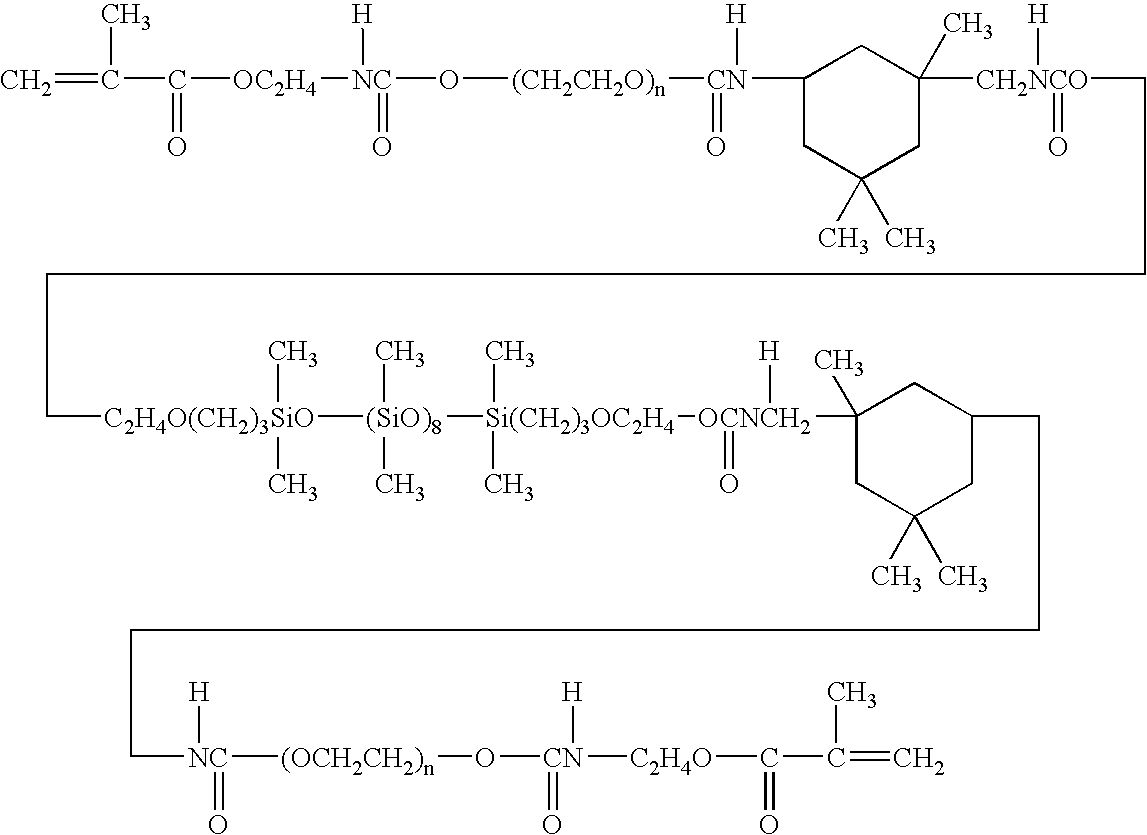Silicone-containing ocular lens material with high safety and preparing method thereof
a technology of ocular lens and silicon dioxide, which is applied in the field of ocular lens material, can solve the problems of low copolymerizability of contact lens inferior to keep its shape, inability to say that it can permeate the oxygen necessary for the cornea, and low copolymerizability of alkyl (meth)acrylate and alkyl (meth)acrylamide which are industrially and frequently used
- Summary
- Abstract
- Description
- Claims
- Application Information
AI Technical Summary
Benefits of technology
Problems solved by technology
Method used
Image
Examples
examples 32 and 33
[0198] After plasma irradiation (an output power of 50 W and a pressure of 100 Pa, for 3 minutes) under oxygen atmosphere was carried out for polymers before hydration which were obtained by using the similar mixed solutions as Examples 1 and 11, they were immersed in an aqueous solution (5.0% by weight of diethylene glycol diallyl ether was contained) of 5.0% by mol of N-VP and graft polymer films were formed by heating at 60° C. for 30 minutes. Hydration treatment was carried out to obtain contact lenses. The evaluation results were shown in Table 15.
examples 34 and 35
[0199] After plasma irradiation (an output power of 50 W and a pressure of 100 Pa, for 3 minutes) under oxygen atmosphere was carried out for polymers before hydration which were obtained by using the similar mixed solutions as Examples 1 and 11, they were immersed in an aqueous solution (5.0% by weight of tetraethylene glycol dimethacrylate was contained) of 1.0% by mol of MPC (2-methacrylolyloxyethylphosphoryl choline) and graft polymer films were formed by UV irradiation for 10 minutes. Hydration treatment was carried out to obtain contact lenses. The evaluation results were shown in Table 15.
examples 36 and 37
[0200] Glow discharge (a pressure of 13 Pa and an RF output power of 40 W, for 5 minutes×twice) under tetramethoxysilane (TMS) / oxygen (a gas flow ratio of 1 / 2 sccm) atmosphere was carried out for polymers before hydration which were obtained by using the similar mixed solutions as Examples 1 and 11, and plasma polymerized films were formed. Hydration treatment was carried out to obtain contact lenses. The evaluation results were shown in Table 15.
PUM
| Property | Measurement | Unit |
|---|---|---|
| elongation | aaaaa | aaaaa |
| temperature | aaaaa | aaaaa |
| temperature | aaaaa | aaaaa |
Abstract
Description
Claims
Application Information
 Login to View More
Login to View More - R&D
- Intellectual Property
- Life Sciences
- Materials
- Tech Scout
- Unparalleled Data Quality
- Higher Quality Content
- 60% Fewer Hallucinations
Browse by: Latest US Patents, China's latest patents, Technical Efficacy Thesaurus, Application Domain, Technology Topic, Popular Technical Reports.
© 2025 PatSnap. All rights reserved.Legal|Privacy policy|Modern Slavery Act Transparency Statement|Sitemap|About US| Contact US: help@patsnap.com



